Using Picture Books To Teach Biography Writing
Living literature isn’t just for reading but also for teaching writing styles! Serious writing lessons don’t start in our homeschool until middle and high school, but believe it or not, I often use picture books to help me teach.
Since picture books can be read in one sitting, they are perfect examples of good writing from master writers. Of course, you must ensure you’re reading books written by master writers (not twaddle.) And that’s what I’ve set out to share with you in this series – books perfect for teaching various writing styles!
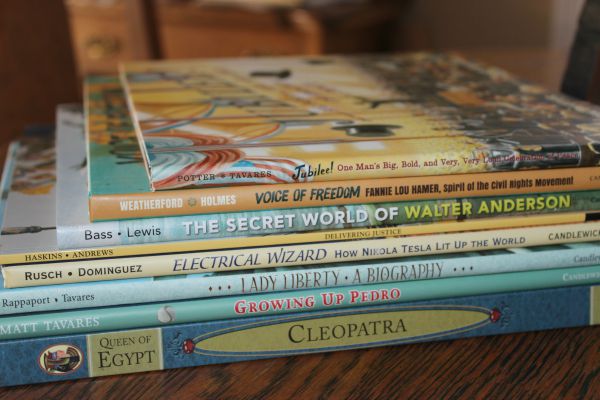
This article focuses on writing biographies. Wait, did I hear a “Yuck!”? If your children are reading this, I’m pretty sure I heard several of them! Historically, biographies are not very fun to read—and definitely not fun to write.
The word “boring” comes to mind when I think about reading most biographies. The words “research” and “bibliography” come to mind when I think about writing biographies. None of those words strike the fancy of most students (or their parents.)
I’m here to change all that deary talk today, though!
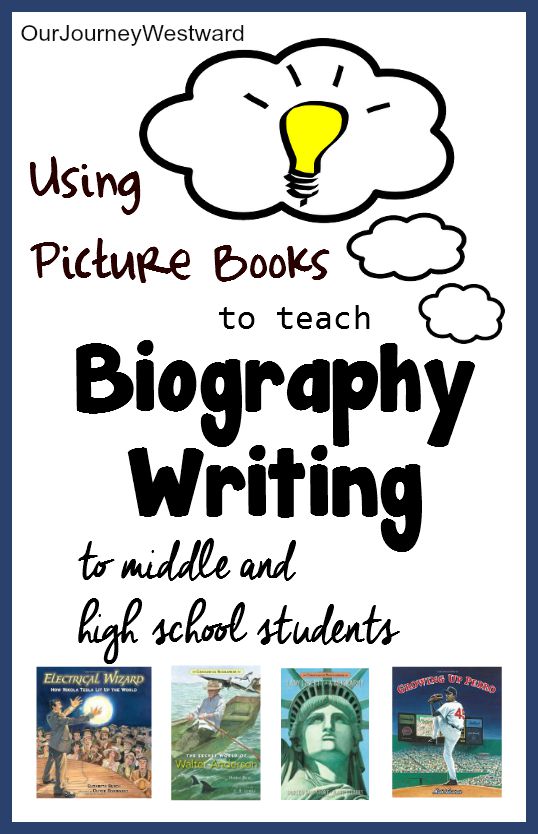
Candlewick Press was kind enough to provide copies of several biographies for me to use in writing this post. They have also compensated me for highlighting their books in my lessons.
There are some excellent living biography picture books out there these days. Rather than simply listing bland facts, these stories weave biographical information into actual storylines. They are stories that will grab the attention of all ages! While you can find living biographies in more than one place, you can be sure the biographies from Candlewick Press will be solid, full of life, and never dull!
Teach Biography Writing
My 10th-grade son had written several personal narratives and some biography book reports, but he had never written a full biography—until now! Before jumping right in, we took a few days to prepare by reading several biography picture books together—one or two per day.
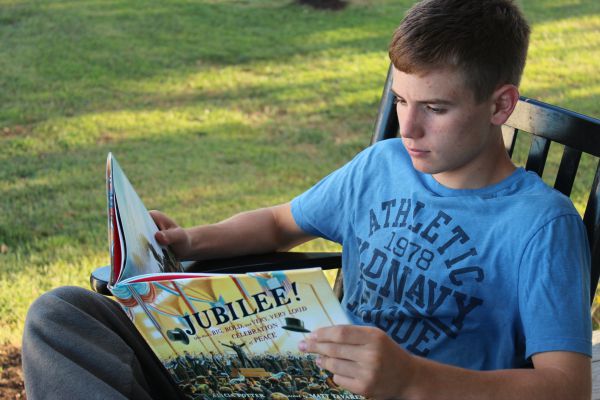
- The Secret World of Walter Anderson by Hester Bass
- Delivering Justice: W.W. Law and the Fight for Civil Rights by Jim Haskins
- Jubilee! One Man’s Big, Bold and Very, Very Loud Celebration of Peace by Alicia Potter
- Growing Up Pedro: How the Martinez Brothers Made it from the Dominican Republic All the Way to the Major Leagues by Matt Tavares
- Electrical Wizard: How Nicola Tesla Lit Up the World by Elizabeth Rusch
By the fourth day, we began biography writing slowly with a new mini-lesson each day. These five books were poured through time and time again during the mini-lessons. I owe so many thanks to these authors!
The Secret World of Walter Anderson (Candlewick Biographies)Delivering Justice: W.W. Law and the Fight for Civil RightsJubilee!: One Man’s Big, Bold, and Very, Very Loud Celebration of PeaceGrowing Up Pedro: Candlewick Biographies: How the Martinez Brothers Made It from the Dominican Republic All the Way to the Major LeaguesElectrical Wizard: Candlewick Biographies: How Nikola Tesla Lit Up the World
What’s a writing mini-lesson? When you choose to focus on one writing topic rather than throwing the whole shebang at your child at once. (Yeah. That’s my very own definition.)
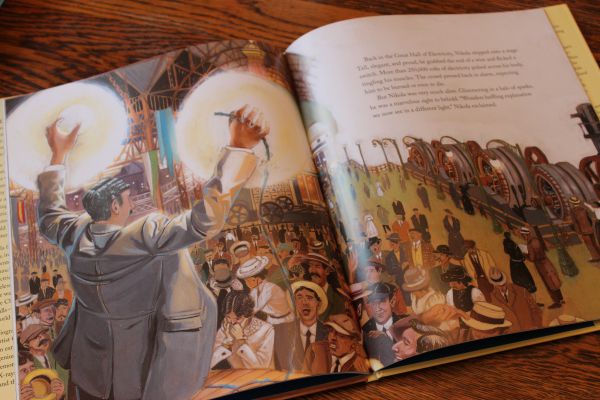
Mini-Lesson #1: Choose a Unique Character
One of the reasons I chose Candlewick Press to help me teach biography writing is that many of their picture books are about out-of-the-ordinary people. There are many biographies about George Washington, Harriet Tubman, and Benjamin Franklin, but few about Pedro Martinez, Nicola Tesla, and W.W. Law.
I reminded my son how interesting each of the five picture books from the previous days was because every main character was new to us. We had never heard their stories—even if we had learned about their time period previously. We talked about how refreshing it was to read something new and how refreshing it would be to unveil someone new in his writing.
Assignment #1: Choose a unique character for your biography. (He chose Les Paul because he’s my guitar kid.)
Mini-Lesson #2: The Bibliography
A bibliography is a listing of resources used in research. To write a biography, you have to research that person. While my son doesn’t mind the research so much, he does mind keeping track of the information in the form of a bibliography. But that’s part of it, and I set out to prove that before he ever started writing. With all five example books piled before us, I challenged him to find just one without a bibliography. He couldn’t.
We spent the next few minutes taking a peek at two things:
- How the bibliography was designed in each book.
- What types of sources the authors used in their study.
Assignment #2: Begin your research of Les Paul. For each new source, take notes on a new piece of paper. Note the resource information at the top of each paper.
Mini-Lesson #3: Facts – To List Facts or Weave Them?
While my son was still researching, we looked through several books to see if and how facts were included in the stories.
While browsing Growing Up Pedro, we kept track of how many pieces of factual information we came across and noted them quickly. I took the time to narrate a “boring” biography using only those facts. Then, I took the time to narrate the same facts within the context of a story (similar to the original story). He noticed the difference.
Browsing through Jubilee!, we again noted the facts. This time, I asked him to narrate the “boring way” and the “story way.” My son is all about facts, so this was a tad difficult for him. That’s okay! We repeated the exercise with Delivering Justice the next day.
This mini-lesson was very important for two reasons:
- Jotting down the facts was good practice for choosing what’s important to note during his research time.
- Adding oral narration gave him the all-important auditory connection to his learning style.
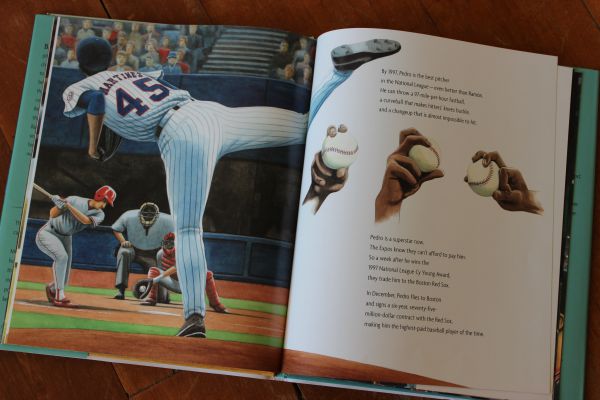
Mini-Lesson #4: The History Behind the Person
While he was still researching Les Paul (because research usually takes way more time than actual writing), we took some time to discuss how history is often woven into biographies. In many cases, it’s important for the reader to understand the time period to understand the person.
We again looked through Delivering Justice, but this time, our eyes were looking for historical cues. I had him jot down simple history notes as they were revealed in the story. We talked specifically about how the historical facts were gently presented as part of the story rather than bluntly. Because of my son’s tendency toward facts, I wanted to constantly reiterate and demonstrate how to incorporate facts into the storyline.
Mini-Lesson #5: The Place Behind the Person
During this mini-lesson, my son was still in research mode. Much like the last lesson, this one demonstrates how to incorporate the setting within the storyline rather than bluntly. Because the settings of Jubilee! and The Secret World of Walter Anderson are both beautiful (in very different ways) and painted in such vivid picture words, we spent two days with these books.
On the first day, I reread one of the books without showing him the pictures and asked him to draw what he heard. Hearing the descriptive language and turning it into pictures was another great auditory exercise.
On the second day, we read the second book and noted the descriptive language as it pertained to the setting. I challenged him to be prepared to paint pictures with words when he began crafting his biography.
Mini-Lesson #6: The Early Life, The Journey, The Big Accomplishment
My sweet boy tends toward unorganized writing. To help him organize his thoughts from the get-go, we planned three main sections of the story right away: Les Paul’s early life, his journey toward fame, and his big accomplishment(s).
Browsing quickly through Electrical Wizard and Growing Up Pedro gave him clarity about how living biographies move seamlessly from one section to the next.
Assignment #3: Begin writing your biography of Les Paul – keeping the story in three main sections.
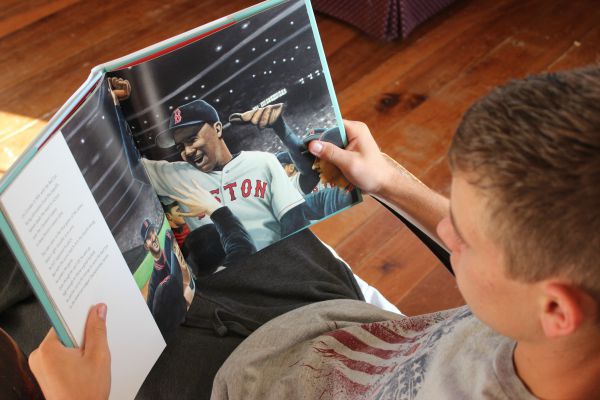
Mini-Lesson #7: Descriptive Language
Descriptive language can be the difference between a decent story and a fabulous story. After a couple of days of fast and furious writing, it was an excellent time to take a break to look through Electrical Wizard and Jubilee! with an eye toward descriptive language.
When we found great example sentences, I asked him to retell the sentences without the descriptive language. In other words, I wanted him to give me the boring version. To turn a great sentence into a boring one is more challenging than you might think! This might seem counter-intuitive, but I wanted him to see that it’s just as easy to develop a great sentence full of descriptive language as it is to write a dull one. I also wanted him to understand how deflated the sentences became compared to the original ones.
Assignment #4: Review your biography and add descriptive language to boring parts.
Assignment #5: Complete the 1st draft. Don’t forget to add the bibliography.
Assignment #6: Reread for an organizational edit.
Assignment #7: Reread for a grammar and punctuation edit. Print and turn in to Mom.
Assignment #8: Complete edits suggested by Mom. Print and read aloud to the family.
HE WROTE A GREAT BIOGRAPHY!
Mini-Lesson #8: Biography Style
My son successfully finished his biography of Les Paul in a similar style to his favorite of the Candlewick example books, Growing Up Pedro. The whole process took about three weeks—maybe a little longer. It may seem like a really long time to write one paper, but this was the teaching paper. Because we spent so much time digging in with master authors and nitty-gritty mini-lessons, he’ll be able to whip out another biography in half the time (probably less) next time around!
Before we jetted off to the next thing, I thought it was important for him to realize that biographies come in all shapes and sizes. Besides picture books, I ordered biographies in the form of chapter books, poetry, notebooks, and snapshots of moments in time from Candlewick Press. We took a few days to go through at least one example book for each additional style of biography writing. We compared and contrasted each new style to the others and discussed the pros and cons for both the reader and the writer of each model.
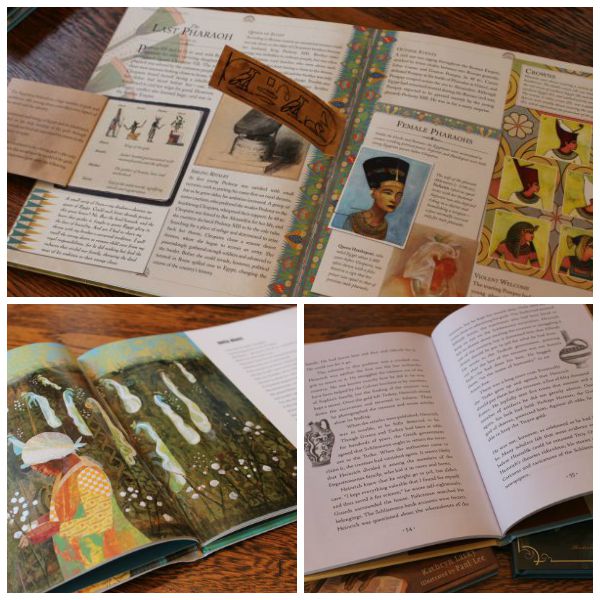
CHAPTER BOOK BIOGRAPHIES
The Hero Schliemann: The Hero Who Dug for Troy by Laura Amy Schlitz
A Voice of Her Own: The Story of Phyllis Wheatley, Slave Poet by Kathryn Lasky
Lincoln and His Boys by Rosemary Wells
The Hero Schliemann: The Dreamer Who Dug for TroyA Voice of Her Own: Candlewick Biographies: The Story of Phillis Wheatley, Slave PoetLincoln and His Boys
BIOGRAPHY POETRY
Voice of Freedom: Fannie Lou Hamer, Spirit of the Civil Rights Movement by Carole Boston Weatherford
Voice of Freedom: Fannie Lou Hamer: The Spirit of the Civil Rights Movement
HISTORICAL NOTEBOOKS
Cleopatra: Queen of Egypt by Ian Andrew
Cleopatra: Queen of Egypt (Historical Notebooks)
BIOGRAPHY SNAPSHOTS OF MOMENTS IN TIME
Lady Liberty: A Biography by Doreen Rappaport
Lady Liberty: Candlewick Biographies: A Biography
Thanks for hanging with me through this giant post! I really wanted you to see how I incorporate picture books in writing lessons from day one to the end of a writing project. It’s a process, but it’s fully worth it when those final drafts consistently improve! I would LOVE to hear your stories about using picture books to make your children better writers!
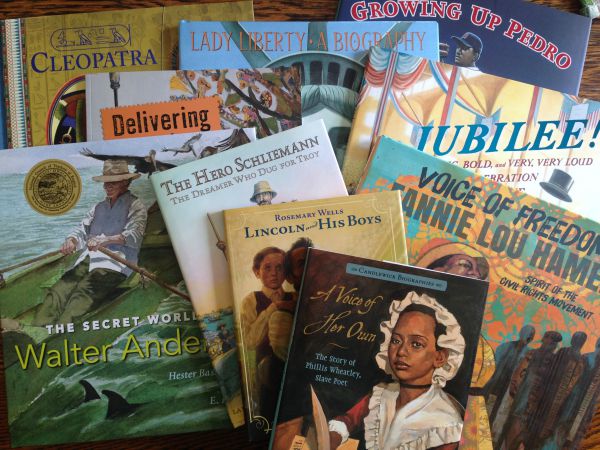
And a huge thanks to Candlewick Press for publishing great biographies! If you’re on social media, keep up with them on Facebook, Twitter, Google+, Pinterest, or YouTube. I especially like their Pinterest page, where they’ve categorized their book titles into learning themes!
Need a little more help learning how to implement this teaching method?
I taught a practical class that can help!
-
 Product on saleHow To Teach Writing With Picture Books MasterclassOriginal price was: $20.00.$10.00Current price is: $10.00.
Product on saleHow To Teach Writing With Picture Books MasterclassOriginal price was: $20.00.$10.00Current price is: $10.00.
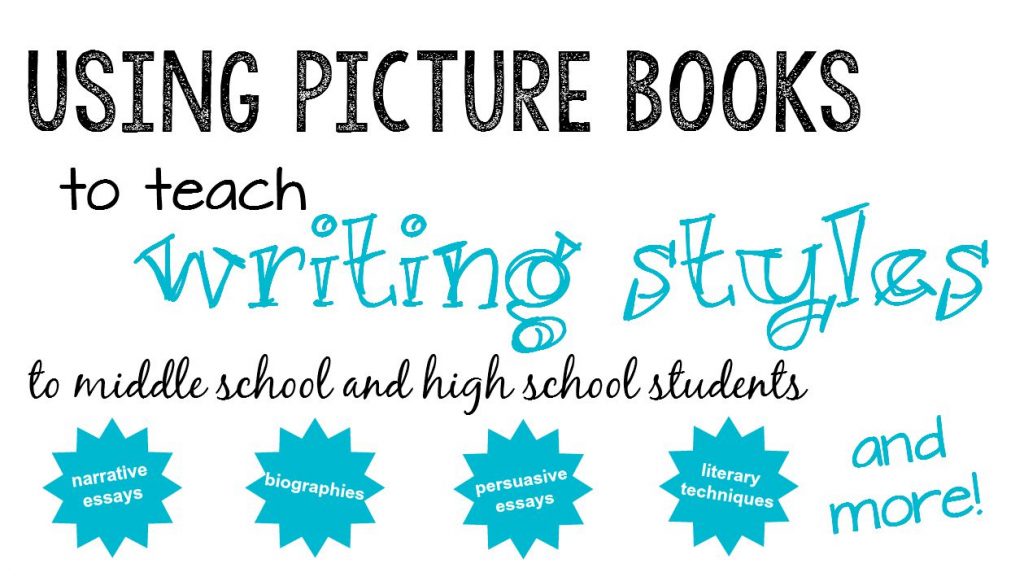
Be sure to check out the other posts in this series to get ideas for teaching several writing styles through picture books!









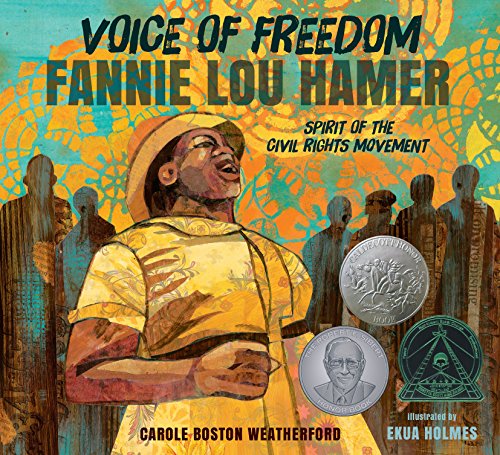



Thank you thank you thank you for this post! I am so excited I found you!! This is the best post ever on how to write a biography. Thank you so much. And thank you for introducing me to Candlewick Press. 🙂
This is a fantastic post and I now definitely want to add this to our studies!!
I loved this post! My son is in 8th grade and I use picture books all of the time. They are wonderful for teaching so many things and I find myself browsing the picture book department of our book store more often than any other area. I love that you shared the details of this lesson (and that it was with your son). We will be moving into biography soon, and I will be sure to use your ideas. Thanks so much for sharing–your blog is always an inspiration to push a little more.
P.S. I would love to see any ideas you might have about teaching note-taking strategies
Thanks for such kind works, Carrie! Can’t wait to hear how your children’s biography writing goes!
You are very welcome, Carol!
You’ll love it, Phyllis!
Cindy, this is wonderful! I’m homeschooling my teenage brother and I was wondering how to teach writing using picture books. Since you can teach literature analysis and literary elements using picture books why not also teach writing. You really walked me through the process in this post. I can’t thank you enough for writing this. I always find lovely gems in your blog posts but this one is the most valuable to me and perfectly timed. Please write more posts about teaching writing styles using picture books. 🙂
I’m so glad it was helpful, Ruthie!
I have a slightly off topic question. How do you store your picture books in your home library? Do you store picture book biographies in with your chapter books? I am having home library organization anxiety issues. 🙂
Diana, that’s a great question! I should probably write a post on the topic. The short of it…I store picture books and chapter books separately. I sort all my books by historical era or science topic or math topic or language arts topic or classics. So, anything having to do with the Civil War, for example, is grouped together in the picture book area and again in the chapter book area. I don’t worry with alphabetizing my author or title because there just aren’t that many to sort through.
My biographies are all inserted with either the history or science section in which they “fit.”
My method is really just my personal preference. There are a zillion ways you could store your books. Do whatever makes the most sense to you. 🙂
These posts are amazing!!! Thank you for the inspiration. Love your blog and love you!
I’ve missed you!!! So glad to hear from you. 🙂 I hope all is well!